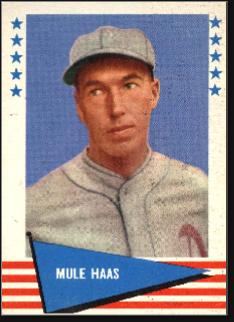
Sport: Baseball
Born: October 15, 1903
Died: June 30, 1974
Town: Montclair, New Jersey
George William “Mule” Haas was born October 15, 1903 in Montclair, NJ. He came from a baseball family. His father, a plumber by trade, was a pitcher who was well known to New Jersey diamond fans. George was nicknamed “Eggs” as a teenager (he would not acquire the nickname “Mule” for another few years). As a boy, he rooted for the local semipro team, the Clairmont Baseball Club; by the age of 18, he was its star. While playing for another team, the Orange Baseball Club, he signed his first professional contract and began his minor-league career in 1923. Two years later he was playing as a reserve outfielder for the Pittsburgh Pirates, who were on their way to the NL Pennant.
The Pirates sold the rookie to the Atlanta Crackers in 1926 and he built up his résumé with two good years in the Southern Association. It was during this time that a local sportswriter gave him the nickname “Mule.” His bat was said to have had the “kick of a mule,” or at least that was his recollection.
Meanwhile, in Philadelphia, Connie Mack was concerned with his aging centerfielder, Tris Speaker. Mack Purchased Mule’s contract for $10,000 and eased him into the lineup in 1928. Shortly after Mule joined the A’s, an old acquaintance was added to the roster. Pitcher George Earnshaw, three years older, had also been a baseball star in central New Jersey.
Mule could hit for average and power, and had terrific speed. He was also a fantastic bunter and a legendary bench jockey. In his first full season, 1929, Mule ranked among the AL’s Top 10 in doubles, homers and runs.
The A’s won pennants in 1929, 1930 and 1931. In Game 4 of the 1929 series against the Cubs, Mule’s three-run inside-the-park homer sparked an historic comeback as the A’s erased an 8–0 deficit to win 10–8. In Game 5, his two-run homer in the bottom of the ninth tied the score 2–2 and Philadelphia went on to win the game (and the series) four batters later when Bing Miller doubled home the winning run.
In 1932, Mack began struggling financial and started selling off his stars. Mule was one of the first to go. He was sold to the White Sox after the 1932 season. He had four good seasons in Chicago before age and injuries limited him to a .207 average in 1937. Mack signed his old center fielder in 1938 for what turned out to be his last year as a big-leaguer. In a dozen seasons, Mule batted .292 and finished with more than 1,200 hits. He is also the only player to lead the AL in sacrifice bunts five years in a row.
Mule played one more minor-league season before accepting a coaching job with the White Sox in 1940. He stayed with the team through the war years, and then moved to the west coast to coach with the Hollywood Stars. After two years as a manager in the Southeastern League, he returned to New Jersey to run the athletic program at Fort Monmouth. He lived to age 70, dying from heart failure while visiting his son George Jr. in New Orleans. He was buried in his hometown of Montclair.